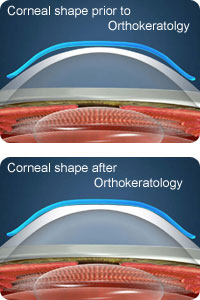
- myopia (nearsightedness)
- hyperopia (farsightedness)
- Astigmatism (irregular surface of the cornea)

OrthoK uses therapeutic gas permeable contact lenses called molds to gently reshape the corneal surface while you are sleeping at night so you can see naturally and clearly during the day without the hassle of glasses and contact lenses.
Patients who wish to control the progression of myopia (nearsightedness). There is growing evidence that OrthoK can stop this progression. This is discussed further in myopia control.
Age: from children as young as 7 years to adults in their 50s to 60s.
Refractive error (eye glasses strength):
- Myopia (nearsightedness): The majority of nearsighted individuals with healthy eyes can benefit from OrthoK!
- Astigmatism: New technology is increasing the treatment range of astigmatism.
- Hyperopia and Presbyopia: New technology also offers custom designs allowing for the treatment of farsighted (hyperopic) individuals, and for bifocal (presbyopic) patient
The best way to find out if you are a candidate is to
schedule a visit with Dr. German Saavedra
for a free consultation.
Of all the optical solutions that have been studied in controlled clinical trials, Ortho-K has been shown to slow myopic progression the most. It is thought that the control occurs due to the lenses creating what is called peripheral myopia. Peripheral myopia is thought to be a significant part of the mechanism that controls the process of emmetropization, which is how the eye determines to stop its growth and myopic progression. An eye with peripheral myopia will generally not become more myopic. Therefore, by artificially creating peripheral myopia using optical devices such as corneal molds, we are able to arrest further myopia progression.
No. If you stop wearing the therapeutic lenses, your vision will return to how it was.
Most patients see dramatic improvement in the first day, with complete vision correction in just a few days.
During the transitional period, you may wear Orthokeratology therapeutic lenses for part of the day. You may also wear other temporary soft contact lenses. This is a decision Dr. Saavedra will discuss further with you.
Absolutely. You can see with the lenses on or off. So if you have to get up at night, no problem.
There is a risk of infection when any contact lens is worn. However, during the FDA clinical study, there were no serious adverse events observed. The old reports of serious infection were based in Asia, and were from more than 10 years ago when the fitting of orthokeratology therapeutic lenses was not regulated. Proper handling such as contact lens hygiene can be discussed further with Dr. Saavedra.
